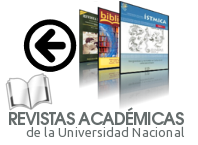Determinants of Costa Rica's International Trade of Wastes and Its Relationship with the Circular Economy
DOI:
https://doi.org/10.15359/ri.94-1.6Keywords:
Circular economy, Costa Rica, Econometrics, International trade, Waste, Poisson Gravity ModelAbstract
As the circular economy has evolved into a new development model, international trade of wastes, scraps, and residues has grown with significant relevance in this new century. Costa Rica represented less than 0.1 percent of the total amount of world waste exports by the end of 2020, however; it can make a transition to a circular economy through this international trade trend. This article explores the determinants that propel Costa Rica to participate in this type of international trade. Through the application of a Poisson pseudo maximum-likelihood gravity model with a 2018 cross-sectional database of 47 countries, it is determined that Gross Domestic Product of importing countries, their population sizes, their services sectors’ size in terms of GDP, as well as their environmental performance, are all significant determinants. Trade of wastes should not be a form of exporting problems to other nations, but a means to take the local circular economy to a global scale.
References
Banco Central de Costa Rica (2019). Exportaciones FOB, Retrieved December 2020 from: https://gee.bccr.fi.cr/indicadoreseconomicos/Cuadros/ frmVerCatCuadro.aspx?idioma=1&CodCuadro=%2028.
Chatham House (2019). Circular Economy.earth:Costa Rica/All countries/Wastes, Scraps and residues/2018. The Royal Institute of International Affairs, Retrieved December 2020 from: https://circulareconomy.earth/trade?year=2018&exporter=188&category=6
Ellen Macarthur Foundation (2015). Towards a Circular Economy: Business Rationale for an accelerated transition. Retrieved from: https://www.ellenmacarthurfoundation.org/assets/downloads/TCE_Ellen-MacArthurFoundation_9-Dec-2015.pdf
Geissdoerfer, M. et al. (2017). The Circular Economy: A new sustainability paradigm? Journal of Cleaner Production 143, 757-768. Retrieved from: https://www.academia.edu/31149296/
The_Circular_Economy_A_new_sustainability_paradigm Geodatos (2020). Distancia entre ciudades. Retrieved December 2020 from: https://www.geodatos.net/.
Higashida, K. and Managi, S. (2013). Determinants of trade in recyclable wastes: evidence from commodity-based waste of waste and scrap. Environment and Development Economics, 19, 250-270. Retrieved from: https://www.jstor.org/stable/26391772?seq=1
Isard, W. and Peck, M. (1954). Location theory and International and Interregional Trade Theory, Quarterly Journal of Economics, 68 (1), 97-114. Retrieved from: https://academic.oup.com/qje/article abstract/68/1/97/1841786?redirectedFrom=fulltext
Kellenberg, D. (2012). Trading Wastes. Journal of Environmental Economics and Management, 64, 68-87. Retrieved from: https://www.sciencedirect.com/science/article/abs/pii/S0095069612000174
Kellenberg, D. (2012). Trading Wastes. Journal of Environmental Economics and Management, 64, 68-87. Retrieved from: https://www.sciencedirect.com/science/article/abs/pii/S0095069612000174
Kumar, S., Giridhar, V., & Sadarangani, P. (2019). A Crossnational Study of Environmental Performance and Culture: Implications of the Findings and Strategies. Global Business Review, 20(4), 1051–1068. doi: org/10.1177/0972150919845260.
Organization of Economic Development and Cooperation. (2018). Global Material Resources Outlook to 2060: Economic drivers and environmental consequences. Paris, France: OECD Publishing, Paris. Retrieved from: http://www.oecd.org/environment/global-material-resources-outlook-to-2060-9789264307452-en.htm
Ravenstein, E. (1885). The Laws of Migration, Journal of the Royal Statistical Society, 48, 167-227. Retrieved from: https://cla.umn.edu/sites/cla.umn.edu/ files/the_laws_of_migration.pdf
Silva, S. and Tenreyro, S. (2006). The log of gravity. The Review of Economics and Statistics, 88(4), 641-658. Retrieved from: https://personal.lse.ac.uk/tenreyro/jensen08k.pdf
Tinbergen, J. (1962). Shaping the world economy: suggestions for an international economic policy, New York, United States: The Twentieth Century Fund.
United States International Trade Commission. (n.d.). GME Package documentation: Gravity Estimation Methodology. Retrieved December 2020 from: https://www.usitc.gov/data/gravity/gme_docs/estimate_technical/
Van Bergeijk, P. and Brakman, S. (2010). The Gravity Model in International Trade: advances and applications, Cambridge, United Kingdom: Cambridge University Press.
Wen, J., Hao, Y., Feng, G.F., & Chang, C.P. (2016). Does government ideology influence environmental performance? Evidence based on a new dataset. Economic Systems, 40(2), 232–246. Retrieved from: https://doi.org/10.1016/j.ecosys.2016.04.001
Wendling, Z., Emerson, J., de Sherbinin, A., Esty, D. C., et al. (2020). 2020 Environmental Performance Index. Yale Center for Environmental Law & Policy. Retrieved December 2020 from: https: //epi.yale.edu/downloads
World Bank Group (2021). What a waste 2.0: a Global Snapshot in Solid Waste Management to 2050. Retrieved December 2020 from: https://datatopics. worldbank.org/what-a-waste/trends_in_solid_waste_management.html
World Bank (2020). World Development Indicators. World Bank Group, Retrieved December 2020 from: https: databank.worldbank.org/source/world-development-indicators.
Yamaguchi, S. (2018), International Trade and the Transition to a More Resource Efficient and Circular Economy: A Concept Paper. OECD Trade and Environment Working Papers, 2018 (03), Retrieved from: https://doi.org/10.1787/847feb24-en.
Published
How to Cite
Issue
Section
License

Revista de Relaciones Internacionales por Universidad Nacional de Costa Rica está bajo una Licencia Creative Commons Atribución-NoComercial-SinDerivar 4.0 Internacional








1.png)







3.png)
